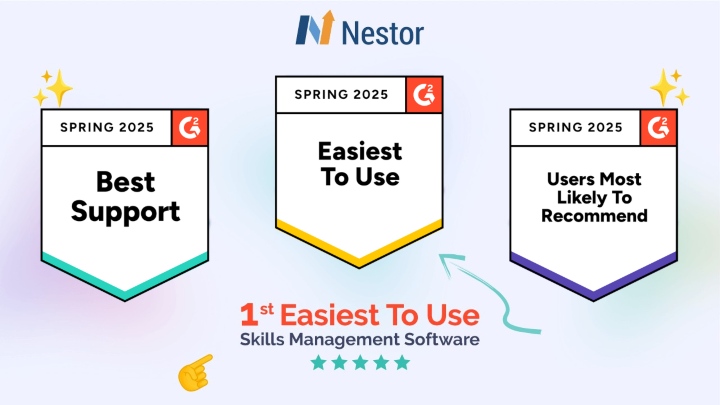Raluca Apostol, CPO and Co-founder of Nestor at WomenTech Global Conference 2024
8 min read

Our very own CPO, Raluca Apostol, who is also the co-founder of Nestor, tackled the pressing issue of the skills shortage at the WomenTech Network Global Conference 2024 in her insightful session, “The skills shortage is a serious problem. Will AI come to the rescue?”
Raluca explored how by combining AI capabilities with a skills-first approach, organizations can more effectively address the skills shortage, improve talent management, and create more dynamic and adaptable workforces. Her insights emphasized aligning skills taxonomies with market trends, leveraging AI for productivity gains, optimizing career development, and many other strategies to address skill gaps.
Insights on skills gaps
Understanding skills gaps is crucial for organizations aiming to stay competitive and adaptive. These gaps often highlight the disparity between current capabilities and future needs, necessitating strategic interventions such as upskilling, reskilling, or recruiting. Addressing these gaps involves not only identifying technical proficiencies but also fostering soft skills like adaptability, creativity, and critical thinking. By closing these gaps, businesses not only enhance operational efficiency but also cultivate a workforce capable of driving innovation and meeting emerging challenges head-on.
What are Employee Skills and Skills Gaps?
Employee skills encompass the full spectrum of abilities, knowledge, and expertise that individuals bring to their roles within an organization. These skills form the foundation of an organization’s human capital and directly impact its ability to achieve its objectives. Raluca differentiated between two main categories of skills:
- Technical Skills: Technical skills are job-specific abilities required to perform particular tasks or functions. These skills are less transferable, tend to become obsolete very quickly and are typically developed through formal education or acquired through practical work experience. They are essential for most job roles when combined with soft skills. Examples include: programming languages (e.g., Python, Java, C++), digital marketing techniques, mechanical engineering skills, etc.
- Soft Skills: Soft skills, also known as interpersonal or people skills, are behavioral attributes that enhance an individual’s interactions, job performance, and career prospects. These skills are transferable across various roles and industries. They are particularly pertinent in an AI-driven world. While soft skills are often innate, they can be developed and improved over time through practice and targeted training. Key soft skills include: leadership, adaptability, emotional intelligence, problem-solving, etc.
When it comes to skill gaps, she defined them as the mismatch between the skills companies need and those that employees possess. These gaps can manifest at various levels within an organization and across different industries, impacting operational efficiency, innovation capabilities, and overall competitiveness. Skill gaps can be quantitative (not enough people with a particular skill) or qualitative (the skill level is not sufficient to meet the required standard).
90% of organizations say they will have a meaningful skills gap in the coming years and are already facing a severe shortage of key talent.
— McKinsey & Company Report 2023
What causes skills gaps to occur?
Skill gaps arise from various factors, each contributing to the mismatch between workforce capabilities and job requirements. Raluca outlined various causes of skill gaps, including::
- Rapid Technological Advancements: The pace of technological change often outstrips the speed at which workforce skills can be updated. New technologies create demand for new skills while potentially rendering others obsolete.
- Educational and Training Systems: Educational institutions often teach outdated curricula and lack practical training, leading to graduates entering the job market without the necessary skills.
- Demographic Shifts: Workforce demographic changes, like aging or increased diversity, can create skill gaps. Older employees may need updated skills, while younger ones may lack experience in emerging fields.
- Lack of Training and Development Opportunities: Organizations that neglect continuous training risk their employees’ skills becoming outdated, leading to significant skill gaps that impact productivity and innovation.
- Mismatched Expectations: There can be a disparity between what employers expect and what employees or job candidates are prepared to deliver. This mismatch often arises from unclear job descriptions, evolving job roles, or unrealistic expectations from both parties.
- Globalization and Outsourcing: Globalization and outsourcing can create skill gaps as organizations expand into new markets with varying workforce capabilities, potentially losing critical knowledge and expertise to external partners.
- Mismatch Between Supply and Demand: Economic changes and industry trends can cause a mismatch between the supply of workers with certain skills and the demand for those skills, resulting in skill gaps.
- Changing Job Roles and Requirements: As job roles evolve, new skills are needed while others become obsolete. Organizations must continually update job requirements and provide training to ensure employees remain competent in their roles.
How AI helps?
In an era where the half-life of skills is rapidly shrinking and the demand for new competencies is continually evolving, organizations face unprecedented challenges in managing their talent effectively. In this context, AI has emerged as a transformative solution, offering powerful tools to identify, develop, and leverage employee skills with unprecedented precision and efficiency. In her presentation, Raluca specifically addressed how we leverage AI in combination with a skills-first approach. She explored several key areas:
- Having a relevant Skills taxonomy for your business needs: Building a comprehensive skills repository is complex, often disconnected from market trends. AI provides ready-to-use skills taxonomies mapped to job roles, enabling precise skill alignment and proficiency matching. AI suggestions continually update skills based on industry demands.
- Difficulty in recruitment: During skill shortages, AI-powered talent platforms streamline recruitment with data analytics and machine learning. They match candidates to specific skill requirements and predict their success in roles, optimizing hiring decisions and reducing turnover risks.
- Increased competition: In a competitive job market, AI-driven insights guide organizations to offer competitive compensation packages tailored to individual skills. This helps attract and retain top talent while optimizing budget allocation.
- Impact on productivity: AI automates tasks and provides real-time analytics, optimizing resource allocation and project management. This improves productivity by freeing up employees for strategic initiatives.
- Training costs: AI personalizes training programs based on individual skill gaps and learning styles, optimizing training effectiveness and reducing costs. This approach makes training more engaging and efficient.
- Retaining top talent: AI-driven talent management systems identify high-potential employees, recommend personalized career paths, and support ongoing development. This improves retention rates and maintains a motivated workforce.
- Innovation and business performance limitations: AI-driven predictive analytics anticipate market trends and critical skills for innovation. AI tools foster collaboration and idea generation among teams, promoting a culture of continuous innovation.
Let’s not expect that AI will solve everything. AI will help mitigate some of the challenges out there, so that we may overcome skills shortages, but at the same time also unlock some new opportunities for the organizations out there, like how they grow, innovate, and stay competitive in the market.
— Raluca Apostol, CPO and co-founder of Nestor

Ethical AI. What to consider?
Raluca concluded by discussing the importance of ethical AI use in addressing skills gaps. Ethical considerations in AI implementation within workplaces are critical to fostering trust, transparency, and fairness among employees. As organizations increasingly integrate AI technologies into various facets of operations, it becomes imperative to establish robust ethical guidelines. These guidelines not only safeguard employee rights but also mitigate potential risks associated with biased decision-making and data privacy concerns. Implementing AI ethically in the workplace involves:
- Transparency: Clearly communicate to employees how AI is used, what data is collected, and its impact on their employment.
- Bias Mitigation: Implement measures to identify and mitigate biases in AI algorithms used for decision-making to ensure fairness in processes like hiring and performance evaluations.
- Data Privacy: Prioritize data privacy and security by obtaining explicit consent from employees before using their personal data for AI-driven processes.
About WomenTech Network
The WomenTech Network is specifically created to empower women in diverse roles across the technology industry, spanning from entry-level to top executive positions.
Its primary goal is to cultivate a nurturing community that encourages professional development and serves as a platform for inspiring more women to pursue careers in the tech sector.
Learn more about the WomenTech Network.
About Nestor
Nestor is a Skills-based talent management platform that helps HR and business leaders identify, activate, and strategically deploy skills within their organization to drive peak performance, innovation, and growth.
With a market library of over 20,000 skills enhanced by Nestor’s AI skills suggestions, you gain unprecedented visibility into your people’s capabilities and dynamic mapping of their skills.
Our leading platform combines the tools, insights, and decision-making support you need to understand people’s strengths and skill gaps and leverage tailored learning recommendations to unlock hidden potential, in line with career and business goals.
Nestor’s Talent and Opportunity Marketplace helps connect talent with gigs, projects, or new open roles based on AI smart-matching, ensuring people with the right skills are in the right place at the right time.
Nestor is trusted by HR and people leaders in mid-to-large enterprises, including F500 companies, across the US, Latin America, Europe, and the Middle East.
Nestor is rated the #1st Easiest to Use Skills Management Software on G2.










